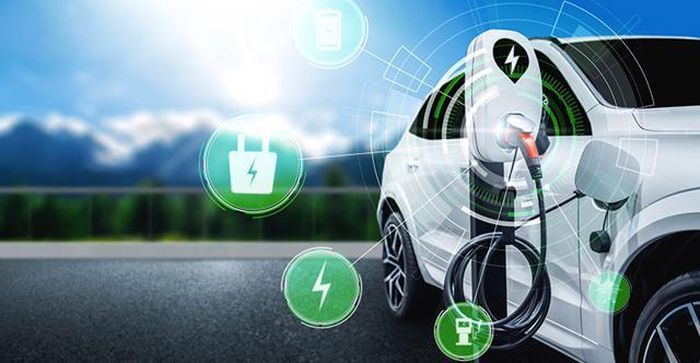The journey to net-zero emissions in the global automotive industry

Emissions from business activities (Scope 1 and 2) account for only about 1% of total emissions. Switching to renewable energy is the best way to reduce Scope 1 and 2 emissions. This can be achieved through directly installing renewable energy sources on site or purchasing electricity from renewable energy suppliers.
Value chain emissions (Scope 3) account for 99% of total emissions. Most of these arise from the production of purchased goods and services and the use of sold vehicles. The industry's main decarbonization strategy is to electrify vehicle fleets. However, most automakers are behind on their electrification goals.
Furthermore, the production of electric vehicles (EVs) emits more emissions than the production of internal combustion engine (ICE) vehicles. This poses additional challenges and means that automakers must adopt circular business models and increase their use of sustainable materials. This will help automakers reduce the environmental impact of electric vehicle production.
Tesla has successfully offset its operations through carbon credits received through its energy business. However, most OEMs should avoid investing in carbon offsets. Carbon offset projects are facing increasing scrutiny from environmental activists over their effectiveness in reducing overall global emissions. Investing in clean technology is a much more effective method to sustainably reduce net carbon emissions, as the carbon offset market is likely to be more tightly regulated
Around the world, regulatory regimes are increasingly driving corporate decarbonization. This takes a number of forms, including:
Stop using fossil fuels. Many governments have committed to phasing out the use of fossil fuels. Several countries have pledged to ban the sale of new petrol and diesel cars by 2035 and many are looking to replace gas boilers with heat pumps. This is a leading commitment to providing more energy from renewable energy sources such as solar and wind.
Pricing emissions. Many countries, including the EU and China, are introducing emissions trading systems or enhancing existing systems to cover more sectors. That means companies with higher emission value chains will face higher costs.
Mandatory reporting. Mandatory sustainability reporting standards are being adopted globally. In 2023, the International Sustainability Standards Board published standards that are widely expected to become the global basis for climate reporting and include Scope 3 emissions reporting requirements Increased transparency will put pressure on businesses to reduce emissions over time.
State support for a low-carbon economy. Governments are competing for leadership in low-carbon technology production. China dominates battery, solar panel manufacturing and the global supply chain. The US aims to reinvigorate production with the Disinflation Reduction Act, announced in 2022, and the EU aims to do the same with the Net Zero Industry Act.
What is zero emissions?
Scope 1 emissions originate from sources owned or controlled by the company.
Scope 2 emissions are emissions from purchased energy. For most companies, this will be money to buy electricity.
Scope 3 is the most difficult computational challenge for most businesses. It includes emissions for which a business is indirectly responsible, through its suppliers and customers. They are created by assets that the business does not own or control.
Net zero emissions means cutting greenhouse gas emissions as close to zero as possible, with remaining emissions being 'offset'. Companies that achieve net zero emissions can say they are 'carbon neutral'.
Companies typically aim to first achieve net-zero operations by reducing Scope 1 and 2 emissions and offsetting purchases. Many auto plants are now demonstrating their Scope 1 and 2 efforts with power turbines and extensive use of solar panels for power. De-energize production activities and replace power sources that emit more CO2 from the grid
Companies can then achieve net zero by reducing Scope 3 emissions and purchasing offsets to cover the remainder. For most companies, Scope 3 emissions are the largest and most difficult to measure and reduce.
Emissions are offset by supporting projects that reduce emissions or remove greenhouse gases from the atmosphere.
Companies are under pressure to cut emissions as countries aim to meet climate commitments.
Every major economy has signed the Paris Agreement, the global climate agreement that commits signatories to keeping global warming below 2C above pre-industrial levels.
Electrification is key to Range 3
All OEMs intend to ramp up their battery electric vehicle (BEV) and hybrid vehicle offerings over the next decade, with many promising fully electric fleets by 2030. Some automakers Auto is also investing heavily in hydrogen fuel cell electric vehicles (FCEVs), but these manufacturers come with higher development costs and promote infrastructure challenges – and are considered by many is far superior to BEV in large commercial application.
To achieve net emissions targets, OEMs need to prioritize increasing production and sales of EV batteries over hybrid and other low-emission vehicle options. However, there are a number of challenges to OEMs' net zero goals, which are:
Improving electric vehicle production capacity is necessary to achieve electrification goals.
There are some concerns about market demand for electric vehicles. In October 2023, Ford and GM pushed back their electrification and electric vehicle spending targets due to lower-than-forecast demand.
Development of alternatives to lithium-ion batteries and other LEV technologies should continue as supply fluctuations in the battery market could cause unforeseen spikes in raw material prices and supply chain disruptions .
Electric vehicle manufacturing emits more emissions than traditional internal combustion engine (ICE) vehicle manufacturing. This means that automakers must also adopt circular business models and increase the use of sustainable materials to minimize the environmental impact of electric vehicle production.
Carbon offsets should be avoided
Carbon offsetting is the reduction or removal of carbon dioxide (CO₂) or other greenhouse gases to compensate for emissions produced elsewhere. Companies buy them to reduce net emissions when they cannot adequately cut emissions from direct operations. In the automotive sector, carbon offsetting is primarily used to reduce Scope 1 and 2 emissions.
For the most part, OEMs should avoid investing in offsets and instead focus on investing in green energy and truly electrifying their fleets. Carbon offset projects, especially afforestation projects, are increasingly facing scrutiny over their questionable carbon neutrality claims, and carbon markets are increasingly viewed by regulators. government management.
Companies may consider setting up carbon removal projects, allowing them to more closely track project performance. However, this requires significant investment. Technology-based carbon removal, such as direct air capture and biochar, where the amount of CO₂ removed is precise and measurable, will be a future option but is not yet available. scaled up and still expensive.
Circular economy and sustainability challenges
The production of electric vehicles (EVs) emits more emissions than the production of internal combustion engine (ICE) vehicles. This poses additional challenges and means that automakers must adopt circular business models and increase their use of sustainable materials. This will help automakers reduce the environmental impact of electric vehicle production.
Automakers are investing in low-emission steel and aluminum in vehicle manufacturing, improving the life cycle of electric vehicle batteries and increasing recycling of old parts and materials.
You should read it
- The catalyst can turn carbon dioxide into plastic
- How are old electric car batteries recycled?
- Successfully manufactured equipment to capture and separate CO2 from emissions for high efficiency and low cost
- CO2 emissions will be used as fuel for cars in the future
- This portable electric chair can reach speeds of 40km / h
- Manufacturing electric cables from plastic waste - The great plan for the situation of plastic waste pollution in the world today
 The 9 largest ransomware attacks in human history
The 9 largest ransomware attacks in human history iPhone users in Vietnam need to know this immediately to avoid disaster
iPhone users in Vietnam need to know this immediately to avoid disaster AMD is expected to use Samsung's 4nm process for its low-end Radeon APUs and GPUs
AMD is expected to use Samsung's 4nm process for its low-end Radeon APUs and GPUs 8 major projects have been canceled by Apple
8 major projects have been canceled by Apple The most powerful women in technology
The most powerful women in technology Elon Musk sued Sam Altman and OpenAI
Elon Musk sued Sam Altman and OpenAI